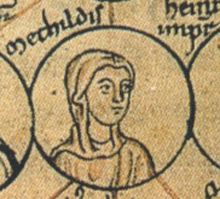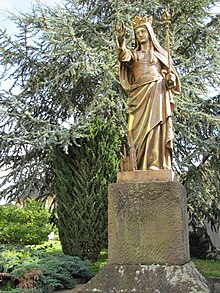
Adelaide of Italy, also called Adelaide of Burgundy, was Holy Roman Empress by marriage to Emperor Otto the Great. She was crowned with him by Pope John XII in Rome on 2 February 962. She was the first empress designated consors regni, denoting a "co-bearer of royalty" who shared power with her husband. She was essential as a model for future consorts regarding both status and political influence. She was regent of the Holy Roman Empire as the guardian of her grandson in 991–995.

Matilda of Ringelheim, also known as Saint Matilda, was a Saxon noblewoman who became queen of Germany. Her husband, Henry the Fowler, was the first king from the Ottonian dynasty, and their eldest son, Otto the Great, restored the Holy Roman Empire in 962. Matilda founded several spiritual institutions and women's convents. She was considered to be extremely pious, righteous and charitable. Matilda's two hagiographical biographies and The Deeds of the Saxons serve as authoritative sources about her life and work.

Theophanu was empress of the Holy Roman Empire by marriage to Emperor Otto II, and regent of the Empire during the minority of their son, Emperor Otto III, from 983 until her death in 991. She was the niece of the Byzantine Emperor John I Tzimiskes. Theophanu was known to be a forceful and capable ruler, and her status in the history of the Empire was in many ways exceptional. According to Wilson, "She became the only consort to receive the title 'co-empress', and it was envisaged she would succeed as sole ruler if Otto II died without a son."

Otto II, called the Red, was Holy Roman Emperor from 973 until his death in 983. A member of the Ottonian dynasty, Otto II was the youngest and sole surviving son of Otto the Great and Adelaide of Italy.

Agnes of Poitou was the queen of Germany from 1043 and empress of the Holy Roman Empire from 1046 until 1056 as the wife of Emperor Henry III. From 1056 to 1061, she ruled the Holy Roman Empire as regent during the minority of their son Henry IV.

Louis V, also known as Louis the Do-Nothing, was a king of West Francia from 979 to his early death in 987. During his reign, the nobility essentially ruled the country. Dying childless, Louis V was the last Carolingian monarch in West Francia.
Ezzo, sometimes called Ehrenfried, a member of the Ezzonid dynasty, was Count Palatine of Lotharingia from 1015 until his death. As brother-in-law of Emperor Otto III, father of Queen Richeza of Poland and several other illustrious children, he was one of the most important figures of the Rhenish history of his time.

Gisela of Swabia, was queen of Germany from 1024 to 1039 and empress of the Holy Roman Empire from 1027 to 1039 by her third marriage with Emperor Conrad II. She was the mother of Emperor Henry III. She was regent of Swabia for her minor son Duke Ernest II of Swabia in 1015, although it seems at that time her husband Conrad was the one who held the reins of government, leading to the enmity between stepfather and stepson.

The Codex Aureus of Echternach is an illuminated Gospel Book, created in the approximate period 1030–1050, with a re-used front cover from around the 980s. It is now in the Germanisches Nationalmuseum in Nuremberg.

Adelaide I, a member of the royal Ottonian dynasty was the second Princess-abbess of Quedlinburg from 999, and Abbess of Gernrode from 1014, and Abbess of Gandersheim from 1039 until her death, as well as a highly influential kingmaker of medieval Germany.
Matilda, also known as Mathilda and Mathilde, was a German regent, and the first Princess-Abbess of Quedlinburg. She served as regent of Germany for her brother during his absence in 967, and as regent during the minority of her nephew from 984.

Sophia I, a member of the royal Ottonian dynasty, was Abbess of Gandersheim from 1002, and from 1011 also Abbess of Essen. The daughter of Emperor Otto II and his consort Theophanu, she was an important kingmaker in medieval Germany.

Matilda, Countess Palatine of Lotharingia, was a member of the Ottonian dynasty.

Mathilde was Abbess of Essen Abbey from 973 to her death. She was one of the most important abbesses in the history of Essen. She was responsible for the abbey, for its buildings, its precious relics, liturgical vessels and manuscripts, its political contacts, and for commissioning translations and overseeing education. In the unreliable list of Essen Abbesses from 1672, she is listed as the second Abbess Mathilde and as a result, she is sometimes called "Mathilde II" to distinguish her from the earlier abbess of the same name, who is meant to have governed Essen Abbey from 907 to 910 but whose existence is disputed.
The Marriage Charter of Empress Theophanu is the dower document for the Byzantine princess Theophanu. Written in Latin, the document was created after the marriage of Theophanu to Emperor Otto II in 972, which made her the empress of the Holy Roman Empire. The document was prepared by Otto II and exemplifies an instance of political and cultural contact between the Holy Roman Empire and the Byzantine Empire.
The history of German women covers gender roles, personalities and movements from medieval times to the present in German-speaking lands.
The Sainte-Chapelle Gospels or the Sainte-Chapelle Gospel Book is an Ottonian illuminated manuscript now housed in the Bibliothèque nationale de France in Paris as Latin 8851. It is made up of 156 parchment folios, in a 38.5 cm by 28 cm format, making it one of the largest manuscripts of its era. It includes miniatures such as the canon tables, Christ in majesty and the Four Evangelists. It is the work of the Master of the Registrum Gregorii, the most famous illuminator of the Ottonian Renaissance.

The Petershausen Sacramentary is an Ottonian illuminated manuscript of around 960–980, produced in the scriptorium of Reichenau Abbey and containing the sacramentary and liturgical calendar. It is now held in the Heidelberg University library.

Otto III, Holy Roman Emperor, also called miribilia mundi, despite his short life, is a historical figure who attracts considerable scholarly attention as well as inspires numerous artistic and popular depictions.

Theophanu (955–991) was a Byzantine princess who became Holy Roman Empress through marriage to Emperor Otto II. As the trusted political partner of her husband and later the regent of her young son Otto III, she left a remarkable legacy as one of the most powerful female rulers of the Ottonian era as well as of the Holy Roman Empire's history in general. Her reign is associated with the exchange of political, religious and cultural ideas and international activities between the Western Empire and the East, including the Byzantine Empire as well as the Slavic countries. Although the empress's personal role in some aspects of these processes is a subject of debate, she is often depicted in historiography and artistic portrayals as a cultured, spirited woman who had to adapt to a difficult situation after her husband's death and whose political vision was unfulfilled due to the early deaths of herself and her son. This image is also influenced by the masculine posture she adopted in her lifetime as coimperatrix and even imperator.


![Adelaide, stained glass, Eglise Sainte-Odile de Lapoutroie [fr], Alsace. Lapoutroie SteOdile 53.JPG](http://upload.wikimedia.org/wikipedia/commons/thumb/6/6a/Lapoutroie_SteOdile_53.JPG/220px-Lapoutroie_SteOdile_53.JPG)






















